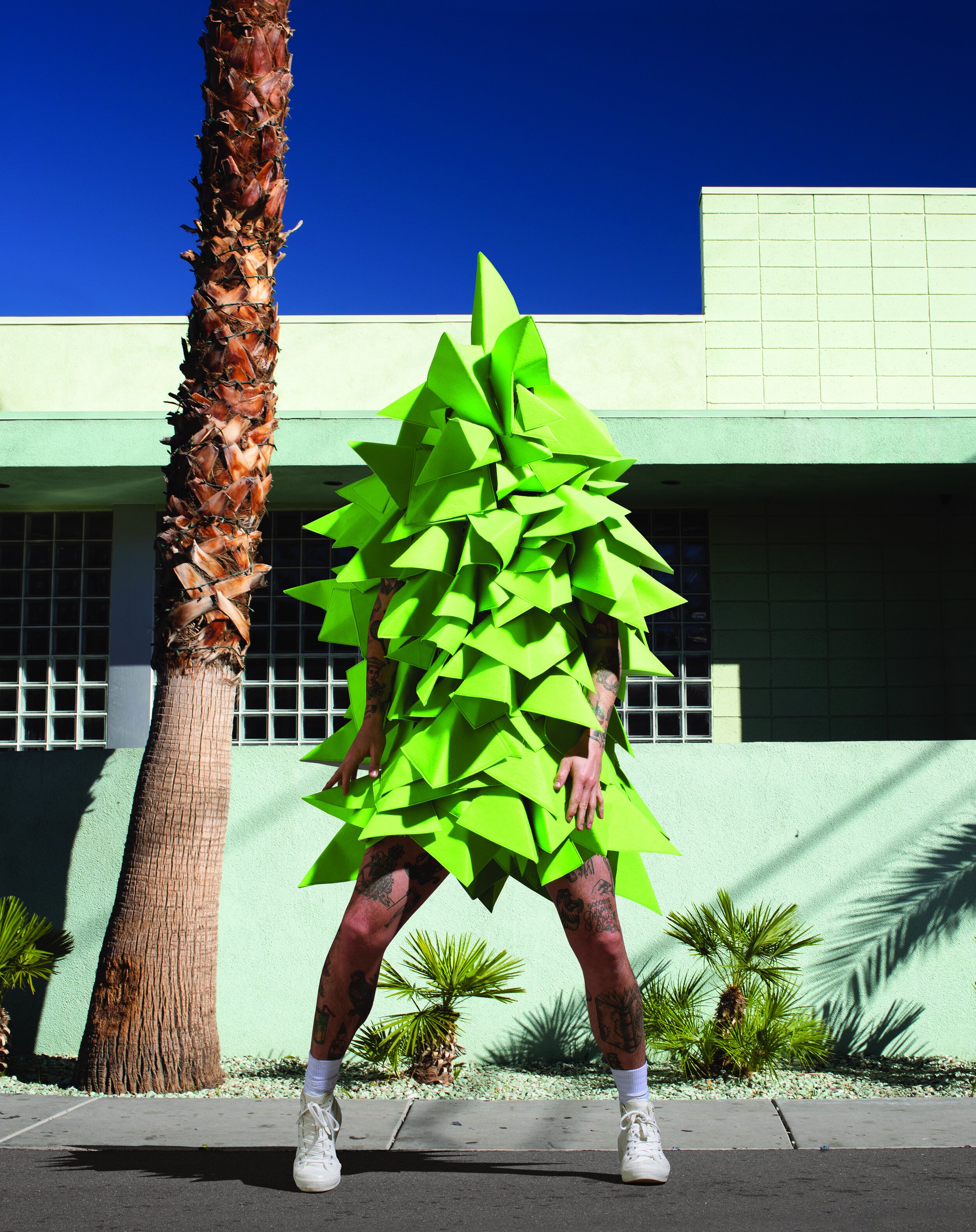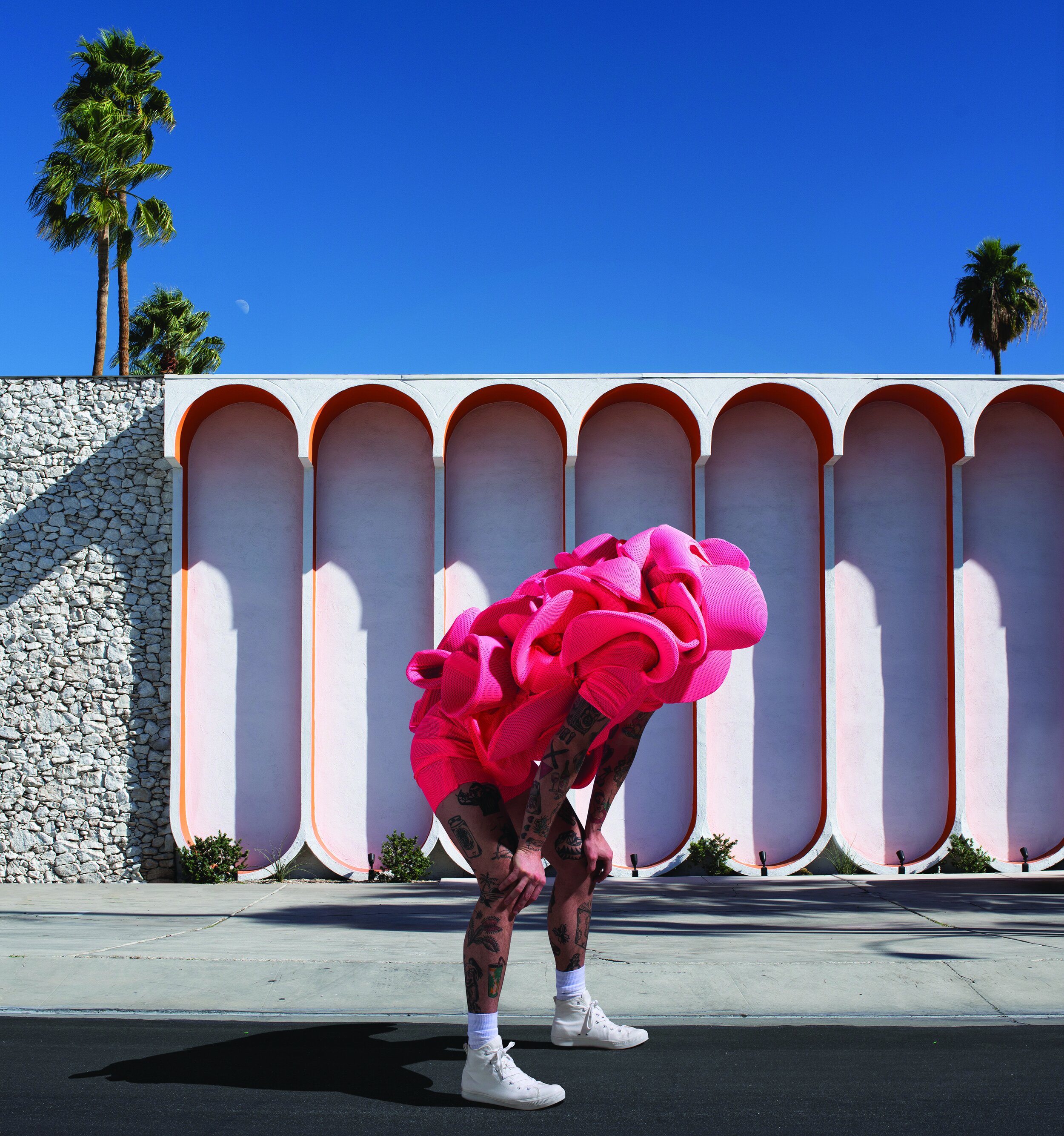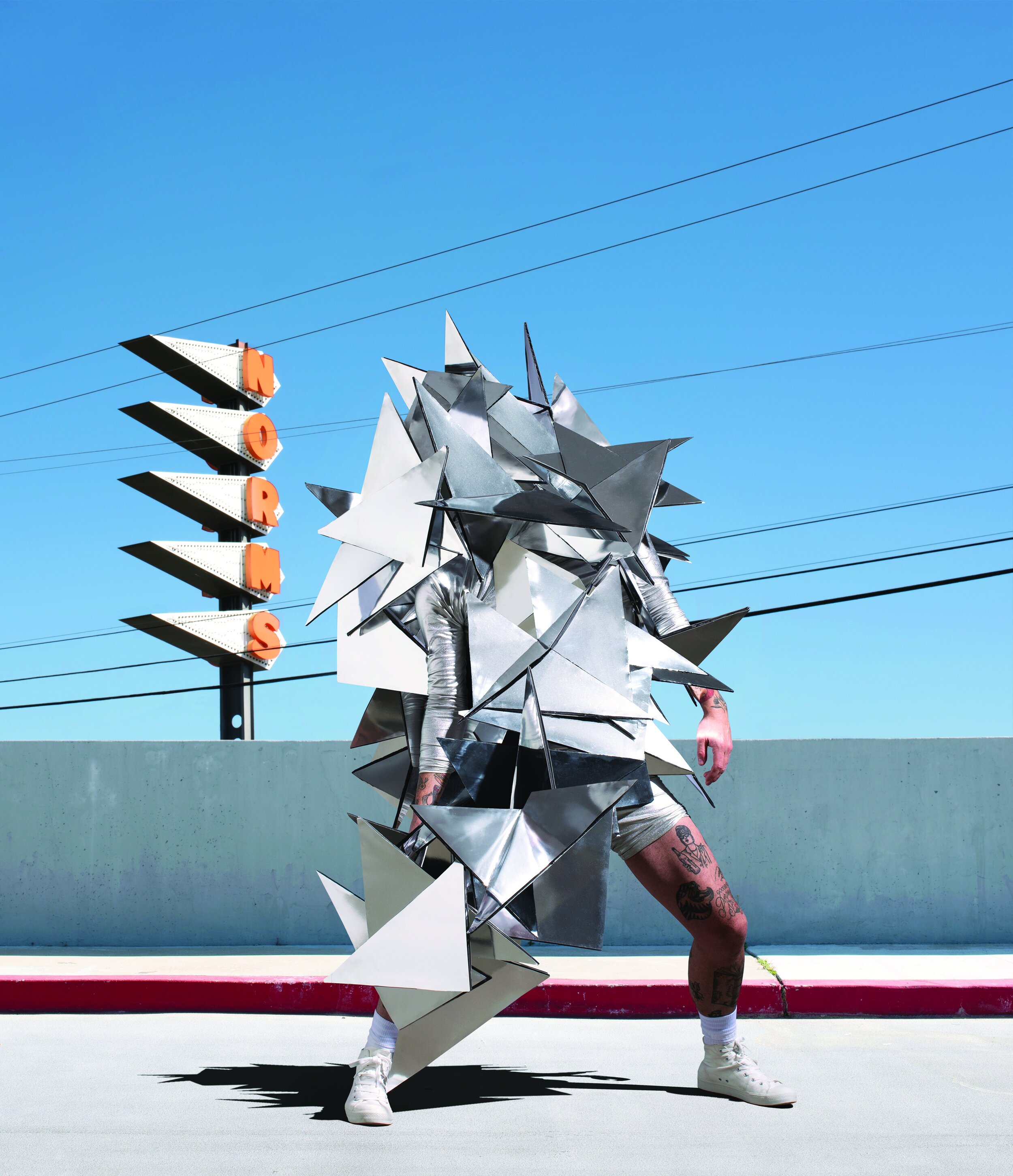I Look Really Good
All of Gerwyn Davies’ photographs are selfies. But instead the reflexive iPhone portraiture we’re accustomed to, Davies buries his own defining features in order to reveal ambiguous, imagined characters – creating art that feels like a gift from another world.
Words by:
Gerwyn Davies & Anna Hutchcroft @annahutch_photo
Photography by:
Gerwyn Davies @ger.wyn
In order to create costumes and experimental sets that explore myth through photography, he scours op-shops and dollar stores with a Magpie’s sensibility – finding shiny materials and garish colours to redeploy in strategies of theatrical self-concealment and fantasy. Here we talk to him about Ballina, creating other worlds, and stepping into them for a time.
Your work requires so much manual labour. You’re the talent but you also build the set, create the costume, and take the photo. What do you get out of having your hands on every step of the process?
I was just talking to someone about this the other day because he was talking about painters who reach a level of their career and get people to come and paint for them. This is crazy to me! I’m such a control freak about the making of my art – I like to be in charge of every single aspect of the process. The thought of someone else stepping in or helping makes me feel really, really uncomfortable.
So no assistants?
No. I’ve had a few people contact me and they’re really lovely and it’s really flattering, but I enter into a certain brain state when making something where I switch off – so then having to snap out of that to talk or give logistical instruction would ruin the making process for me.
Because the final work is photographic, and the process leading up to it is really considered and contrived, the final image is wholly fabricated and I like that that’s all that remains. So there’s this really drawn out process of making costumes, trial and error, performing for the camera, as well as post-production. The final product is sealed and flattened inside the image. The mechanics of the process are buried, hidden away.
What is the experience of being inside one of your costumes? Do you perceive any shifts like ‘stepping into character’?
They’re cumbersome, awkward and really uncomfortable. But the priority of making them is to make distorted sculptural shapes, so practicality is always surrendered in that process. It’s physically very unglamorous and unsexy being inside the costumes, but then there is this seductive feeling of being very alien in your body and queerly moving around that is really exciting. Having the body transformed into this big, sculptural shape brings about something that feels empowering and charged – knowing you’ve taken on this dramatic new form.
I’m often concentrating on posing and not thinking about inhabiting the costume as much. Normally I make them to a point that they’ll be shot and it often looks great from the front but terrible from the back so in that sense I’m kind of half in them but half out of them.
At the moment I’m working on an exhibition at the end of the year at the museum of Sydney and it’s the first time the costumes will be exhibited alongside the photographs. So I’m now returning back to them, making them properly, and hopping in and moving about. I’m really enjoying that – inhabiting the costumes more. It’s a sexy feeling, being completely veiled in this thing, thinking, “I look really good.”
Are you tapping into an internal feeling that exists already or is that something that’s transmitted through the costume?
I think about the potentiality, that moment of transformation. It exists already, but it’s something that the costume accommodates. You know when you put on an outfit and you feel like you look really cool or sexy, there is a little charge in that? And this is the same, but times a thousand because you’re completely shrouded in all these embellished surfaces. I work a lot with materials that are reflective and invite a certain attention but at the same time they offer up an armament, a shield that deflects inspection.
Do the characters you create help you explore your own identity?
I’m not particularly drawn to the fixed idea of a singular, cohesive identity. It’s not something that I’ve ever banked on. The characters I create unhinge from the idea of a fixed identity, and over the last four years I’ve created work that has been about the production of queer figures that unhinge from ideas of fixed identity. They’re not gendered, they’re not specifically human or sculpture, they’re not necessarily still life or representation, and they dissolve the idea of an identity.
Fashion gives us self-expression, but in many cases, its coded signals denote conformity to a certain group. Do the costumes you create speak to this tension?
They sit outside of fashion in that they’re not practical, they’re not responding to any trends and for the most part they’re barely wearable. So my work gets to sit aside from that but I think that anything interesting in “fashion” pushes into the sculptural and away from the functional. I guess my costumes operate within a field of fashion in that it’s kind of adorning the body but it feels very very different to capital ‘F’ Fashion.
You did a lot of shooting in Ballina when you lived up this way…
I love Ballina. I actually think it’s my favourite place in the world, which I know is a huge call! But I like it because of all its inconsistencies. I have to be really careful about wording this because it could sound really pejorative but it’s truly an affectionate thing: I like the lack of self-awareness. I like the lowbrow aesthetics that are popular there. I love all the people on mobility scooters.
It’s this really nice fusion of geriatrics, gays, bogans, surfers and all these people living together in this town that is so optimistically touristy but at the same time quite shit and on the outskirts of somewhere that actually is this tourist mecca. Being there, I feel like I don’t have to try. A supreme resignation. It’s like ‘okay, I’ll just give up’ – in a really nice way. It’s one of those places that you kind of just drift around.
It’s Byron’s ugly stepsister, and for all those reasons, I can’t help but feel this immense affection for Ballina. I can’t understate how much I love it. It’d be easy to misconstrue that it’s a cynical appreciation, but I really just love it. I love it because of its ordinariness, its failures, and I think it’s a truly miraculous place.
Our fascination with identity has taken on strange dimensions with the rise of the selfie. What is your take on selfie filters and the highly curated self-image on social media?
I’m mad for selfies. Obviously there’s rampant narcissism all over social media and intense self-branding that positions individuals as products but I think that’s all well and good as long as people are aware that it’s performance. I don’t understand people’s frustration when they find out that something is fake or photoshopped and the myth unravels before their eyes. That should be obvious – that’s what photography is. But people have this weird idea that the camera doesn’t lie, and that’s actually all the camera does. All the camera does is lie. I love it! I think we should push it further. I think that the way people can perform for their cameras is limitless.
If anything, the dull part is watching photographic trends emerge and people branding themselves in the exact same way – that’s dull, when everyone’s taking photos of themselves the exact same way. But what are the potentials for it? How far can this go? How can you use the camera as a dumb tool for constructing a new reality or transporting yourself into a fantasy world?
On your website you say: “The double bind of a figure both conspicuous and nowhere to be seen, hiding in plain sight, triggers the work’s investment in queering the act of representation and renegotiating the terms of visibility.” I love this. Can you tell us more?
The first sentence is about queering the photographic practice – I was thinking about the camera’s capacity to tweak the truth of the image. People expect the camera to reveal something of the subject’s character and expose them in some way to the viewer. Through my practice and my research with other queer artists, I’m looking at subverting the conditions of that. These artists are hiding from their own cameras, denying the viewer the ability to interrogate and inspect them.
I’m particularly interested in queer artists because the idea of visibility has a lot of resonance for queer people. Representational visibility is the idea that seeing queer characters on television and cinema has a way of accessing more political power – so the more that you’re seen on normative mainstream media, the more power you’ve inherited. But it’s not necessarily an on-off function. What I’m more interested in is rather than appearing and being visible, how can queer subjects can take control of this representational medium and distort it in order to appear and disappear at once? In refusing to concede to the idea of outright visibility, finding ways that are super conspicuous, but at the same time impossible to locate. What are the more complicated ways that we can fuck with the system? And what are the political potentials?
Is it about negotiating it on your own terms?
Of course. The prospect of visibility that’s sold is that if you’re witnessed on-screen, for example, you immediately receive access to political power – but it’s actually a lot more complicated for a lot of queer subjects. Many don’t desire to be seen in those kinds of contexts because it could invite hostility or risk. Rather than just saying all representational visibility is good visibility, and expecting it to unlock the world of political power, how can photography (as a representational medium) be used to generate new forms of political potential that sit outside of the mainstream? It’s not to say visibility is bad, it’s to ask: what more is there? Instead of striving to be fully seen within the normative rules of representation, it’s distorting those and coming up with other ways of being seen that are more personal and more political.
There’s a lot of tension in your work between anonymity and garish presentation – does the self-concealment connect to a desire to reveal? What is the force against revealed representation? Do you hope that your work sparks safer spaces in society to reveal ourselves?
It’s about control. About revealing but at the same time concealing and using this imaging to occupy a queer space of not committing to either. That’s where it’s about controlling the way that you’re seen, and the extent to which you’re seen.
The costumes are garish, using colours and materials to facilitate hyper-visibility. Materials with alluring textures that draw the viewer inward, but simultaneously cover the body to resist penetration. Often the materials have spectral shiny properties that quite literally repel vision so in a photograph, there’ll be highlights where light flickers off the surface and the viewer isn’t able to see beyond it.
When I talk about all of these queer potentails of the image it’s all of these things combined for me. It’s not a figure or a sculpture, it’s not a gendered construction, it’s not a still life, it’s not representation. And it’s always invitation and denial, revealing and concealing. They’re the kind of things that are driving the work. To me, it’s under this banner of camp and queer strategy. It’s this excessive, garish performativity that invites attention but at the same time dictates in what ways people can or cannot access the subject and the image.








